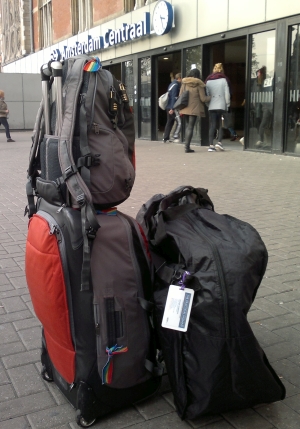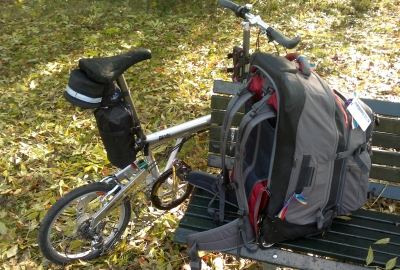Wednesday, 13 March 2024
The Amazing Race 36, Episode 1
Los Angeles, CA (USA) - Puerto Vallarta, Mexico
For season 36 of The Amazing Race, filmed in October 2022, the producers of the “reality” TV show once again chartered a plane to fly the cast and crew between stops. The starting line and this entire first leg of the race were in Puerto Vallarta, Jalisco, on the Pacific coast of Mexico.
Since the racers didn’t have to deal with any flights or long-distance transportation, it was the issues they faced within the city that determined the order of finish of the pairs of contestants. Despite some contrived challenges, the racers faced three major tests of real-world urban travel skills:
1. City driving, navigation, and parking
The racers were required to drive themselves around the city in rental cars. The TV producers didn’t give the racers a choice, but their difficulties highlighted the dubious wisdom, if you do have a choice, of renting a car to get around a dense, unfamiliar city. Even those racers who spoke Spanish had difficulties with driving, parking, and/or navigation.
You can’t count on streets being laid out in a grid, and driving and navigation can be a lot harder in a city than on highways. City street signs are typically smaller and harder to pick out of visual clutter than highway signs. The closer you get to the city center, the more likely you are to encounter pedestrianized streets closed to cars (not always obvious from paper or online maps), one-way streets, dead ends, and parking rules and restrictions that can be inscrutable even if you pull over and get out of your car to read the fine print on the parking signs.
Sometimes parking fees can be paid only through some sort of prepaid parking card only available at limited sales outlets, or through an app that’s only available in the local language or requires a local address, phone number, and/or bank account. One team of racers almost got trapped in a dead-end alley, seeming not to realize that they needed to back out instead of trying to turn around. Another team lost time trying to figure out where near the malecón (beachfront promenade) they could legally park.
Some of the contestants had prepared for The Amazing Race by practicing driving in an unfamiliar city with a (paper) map, since they knew that they wouldn’t be allowed to bring smartphones with them on the race. That’s a good idea for real-world travellers: There will be times, especially (but not only) when you have just arrived in a new country, when you don’t have cellphone coverage or mobile data roaming, and thus don’t have access to maps on your smartphone unless you’ve downloaded maps in advance for offline use.
Even if your cellular provider has a roaming agreement with some Carrier X in Country Y, you might find yourself in a part of Country Y served only by Carrier Z. Or your cellphone might not support the frequencies used in Country X by Carrier Y. You can avoid some of these problems if you always remember to download maps, before you leave for any new country, for everywhere you might go in that country. But the odds are that sooner or later you’ll forget to do that until it’s too late. Murphy’s Law says that will be the country where roaming doesn’t work and there are no cheap local SIM cards (or none that work with the bands your cellphone supports) for sale at the airport or border crossing.
Paper maps are getting harder and harder to find. Sometimes you won’t have any map at all to go by — again, especially if you’ve just arrived and didn’t think to bring a map with you. The racers realized too late that in addition to map-reading they should have practiced urban navigation without a map, relying on signs, landmarks, and/or directions from passers-by.
Understanding and following verbal directions, even if you speak the language, is different from following a map or turn-by-turn directions from a smartphone. The racers regretted that they hadn’t practiced this skill. If you ask people how to get somewhere, they may giver directions by reference to landmarks rather than by route, and may describe streets by attributes or appearance rather than by name. If you want their help, but you can’t understand their mental map, that’s your problem, not theirs!
2. Wheels on cobbles
Cobbled or other stone or brick streets or sidewalks are rare in the USA, but common in some other parts of the world, perhaps especially in older European and Latin American city and town centers. The neighborhoods with streets and sidewalks like this are often among those most visited by tourists. And they may be precisely those streets that are too narrow or too steep for taxis or other cars, or from which they are prohibited.
The racers had to carry or drag large hobby-horses along cobbled streets down a steep hill. The hobby-horses had wheels, but the racers quickly discovered that wheels — especially small wheels like those on the hobby-horses or typical wheeled luggage — don’t work well on cobbles, bricks, or paving stones; on badly broken pavement, unpaved lanes, or hilly streets that turn into steps; or on soft sand, mud, or loose gravel.
Wheeled luggage is, in most of today’s world, an improvement on the prior art of luggage that you actually had to “lug”. But there remain places — including some of the world’s most popular tourist destinations — where dragging wheeled luggage over the cobblestones will be a fairly arduous task. Keep this in mind when you are choosing luggage.
In the USA and some other places where I’m confident of finding more or less smooth asphalt or cement sidewalks and pedestrian paths, I sometimes rely on a “rollaboard” suitcase. But for trips to places where I know cobbles and paving stones are common, or where I’m less sure what to expect, I still use a convertible suitcase that has both wheels and backpack straps. I use the backpack straps only rarely, and they add some weight. But for the times I would otherwise have to drag my suitcase over cobblestone for half a mile into the center-city pedestrian zone to my hotel or hostel, or up or down a long hillside of steps, it’s worth it to me to have them available.

[My luggage arranged for wheeling through the main station in Amsterdam and onto a high-speed train on a multistop European trip: convertible wheeled backpack, detachable daypack, and folding bicycle in carrying bag. The orange panel on the left covers the backpack straps and padded frame.]

[The same luggage set up to carry on my back, with the bike unfolded, the daypack attached to the backpack (at the right-hand side of the photo), and the backpack straps and waist beltmunfolded.]
It you aren’t sure of your own preferences, or whether convertible luggage would be worth the extra weight, here’s a test you can do even if you don’t have any cobblestone streets nearby: Find a coarse, loose gravel road — the worst road you can find, a road too rough to bicycle on — and test what it’s like to drag or carry the luggage you plan to bring on your trip, loaded with the mount of weight you expect to have, for a substantial distance along that rough road.
3. Separating signal from noise
In a challenge that would seem at first glance to have little to do with real-world travel, the racers had to watch a brief lucha libre “battle royale” with ten fighters in the ring at once, and then correctly identify which luchadores had paired off against each other.
Lucha libre has structure and norms, and each luchadore wears a unique and iconic mask designed to make it easy to identity them. For a lucha libre fan, the task for the racers wasn’t intrinsically any harder than for fan of U.S. football to describe who blocked whom in a play they just watched. But the racers didn’t know what to expect, and found it hard at first to make sense of what they were seeing. Most of the racers had to watch a few repetitions before they could match the pairings with the fighters’ masks.
This is the typical pattern of culture shock: When a scene is completely unfamiliar, we don’t have a filter we can automatically apply to separate what’s significant from what’s not, or a contextual framework within which to organize our impressions and reduce complex bursts of movement to easily-remembered notations on our mental scoresheet like “6-4-3 double play”. When we don’t know what to focus on, we are vulnerable both to misdirection (sometimes enabling snatch thievery) and to sensory overload. To a local, for whom the patterns are familiar, it might not even seem noteworthy that a lucha libre exhibition was being staged in the plaza as they walked by.
Link | Posted by Edward on Wednesday, 13 March 2024, 23:59 (11:59 PM)